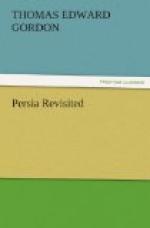The Persian poet-historian Firdausi ascribes to Jamshed the discovery of wine in his leisure from kingly duties and scientific pursuits, for to him is attributed the invention of many useful arts, and the introduction of the solar year for measurement of time, the first day of which, when the sun enters Aries, he ordered to be celebrated by a splendid festival. It is called Nauroz, or New Year’s Day, and is still the greatest festival in Persia. This single institution of former days, under a different religion and system of measuring time, has triumphed over the introduction of Mohammedanism, and is observed with as much joy and festivity now as it was by the ancient inhabitants of Persia.
According to Moulla Akbar’s manuscripts, quoted in Malcolm’s ’History of Persia,’ Jamshed was immoderately fond of grapes, and desired to preserve some which were placed in a large vessel and lodged in a vault for future use. When the vessel was opened, the grapes had fermented, and their juice in this state was so acid that the King believed it must be poisonous. He had some other vessels filled with the juice, and ‘Poison’ written upon each; these were placed in his room. It happened that one of his favourite ladies was afflicted with nervous headaches, the pain of which distracted her so much that she desired death, and observing a vessel with ‘Poison’ written on it, she took it and swallowed its contents. The wine, for such it had become, overpowered the lady, who fell down in a sound sleep, and awoke much refreshed. Delighted with the remedy, she repeated the doses so often that the King’s ‘poison’ was all drunk. He soon discovered this, and forced the lady to confess what she had done. A quantity of wine was then made, and Jamshed and all his Court drank of the new beverage, which, from the circumstance that led to its discovery, is to this day known in Persia as zahr-i-khush, or the pleasing poison. After that the manufacture of wine became a regular industry, and spread from Shiraz, where it originated. At the present time the process of manufacture is similar to what it was then, in that the grape-juice is collected in large Ali-Baba-like jars and buried in the ground. Alexander the Great is said to have followed the festive example of his royal predecessor, and to have drunk deep in the majestic halls of Persepolis. It has been supposed by some that he caused the splendid palaces there to be set on fire in a drunken freak.
As a pendant to the story of a lady’s discovery, in the time of Jamshed, of wine as an efficacious cure for nervous headache, another is told which ascribes to a lady the withdrawal of a royal decree against the sale and use of wine. The Shah Hussein, on his accession to the throne in 1694, displayed his religious zeal by forbidding the sale of wine, and he ordered the destruction of all the stock of it that was in the royal cellars at Ispahan. But his grandmother, by feigning herself ill, and wholly dependent upon wine for cure, not only prevailed upon him to revoke the decree, but also persuaded him to drink some in pure regard to herself, with the result that he fell away from priestly influence and became a tippler. Unfortunately for the nation, this grandmother’s guidance led Shah Hussein to ruin by wine and women, and dragged him down to the deep degradation of surrendering Persia to the cruel tyranny of the Afghan occupation.




